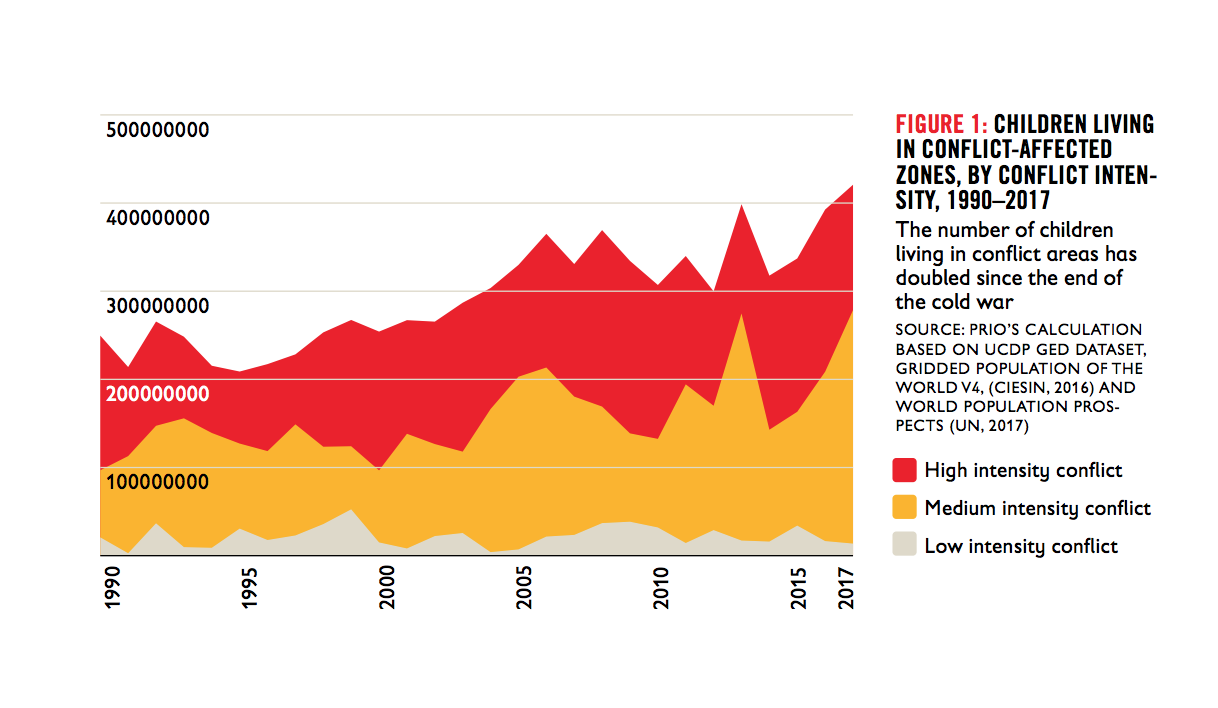Children are getting caught in the crossfire of conflict at a devastating rate, according to a new report by Save the Children and the Peace Research Institute Oslo: Five times more children than combatants are being killed in conflicts around the world.
As the nature of conflict changes – lasting longer, becoming more violent and increasingly being fought among civilian populations – nearly one-fifth of children globally are now living in a conflict zone and suffering the consequences of it. That’s 420 million children in 2017, up 30 million from the year before and double the number since the end of the Cold War.
The report also found that since 2010, the number of “grave violations” against children that have been reported and verified by the U.N. has nearly tripled. These “grave violations” include being recruited by armed groups or abducted, becoming victims of sexual violence, experiencing attacks on their schools, having humanitarian aid denied and, in some cases, being maimed or killed.
The report estimates that between 2013 and 2017, 870,000 children under five years old have died in the 10 countries that have been hardest hit by conflict: Afghanistan, Yemen, South Sudan, the Central African Republic, the Democratic Republic of Congo (DRC), Syria, Iraq, Mali, Nigeria and Somalia. At least 550,000 of them were infants. Compare that to the estimated 175,000 fighters that have died in those countries. The report says these estimates are “indicative and may be highly conservative.”

Many of these children – especially in the DRC and South Sudan – were deliberately targeted. Some died as a result of indiscriminate or disproportionate military action, like in air strikes or by landmines for example. But on a “huge scale” children are dying as a result of the indirect consequences of conflict, including hunger, displacement, lack of access to health care, water and sanitation, high levels of insecurity and denial of aid.
Save the Children says that had these children not been living in conflict zones, they would not have died. In fact, the organization’s conservative estimate is that every year in just the 10 worst countries, at least 100,000 infants die “who in the absence of conflict would survive.”
“Our report shows that the way today’s wars are being fought is causing more suffering for children,” Helle Thorning-Schmidt, CEO of Save the Children International, said in a press release. “It is shocking that in the 21st century we are going backwards on principles and moral standards that are so simple – children and civilians should never be targeted. Our analysis clearly shows the situation is getting worse for children and the world is allowing this travesty to happen.”
The report blames these trends on what it calls a “crisis of compliance.” It’s not that armed actors don’t know the rights of children, but that they are blatantly committing war crimes against them. “And they are often being met by, at best, international indifference and, at worst, complicity,” the report says.
In essence, armed actors – state or non-state – are not holding themselves and their allies to standards of conduct that respect the rights of children. Governments are also failing to take enough action to hold perpetrators accountable for grave violations against children. Additionally, the report says there needs to be more investment in protecting children in conflict – for example through programs that engage with communities to create and enforce safe zones, through psychosocial support and especially through education.
For children in conflict zones, schools should be a safe, protective space that provides a sense of normalcy and routine. Safe and quality education also keeps them on track to pursue better futures. The report estimates that 75 million children across most of the world’s crisis- and conflict-affected countries are in urgent need of support for an education. While 91 percent of children globally attend primary school, only 61 percent of refugee children do.

This week the UN Special Envoy for Global Education and former British Prime Minister Gordon Brown called the world’s young refugees a “lost and invisible generation,” as he pled for new education funding for more than 30 million displaced and refugee young people.
“[They] are broken by the absence of hope, the soul crushing certainty that there’s nothing ahead for which to plan or prepare, not even a place in a school classroom,” he said at press conference in New York.
Just as Brown warned that Sustainable Development Goal 4 (quality education for all) cannot be achieved if we neglect those displaced by conflict, the report says that sustainable peace (SDG 16) cannot be achieved without a concerted effort to address the needs and protection of children in conflict zones. The long-term stability, security and prosperity of the world depend on it.
Thorning-Schmidt writes: “If these children are left behind, we cannot fulfil the promise of the Sustainable Development Goals and lay the foundations for a peaceful and prosperous society.”
